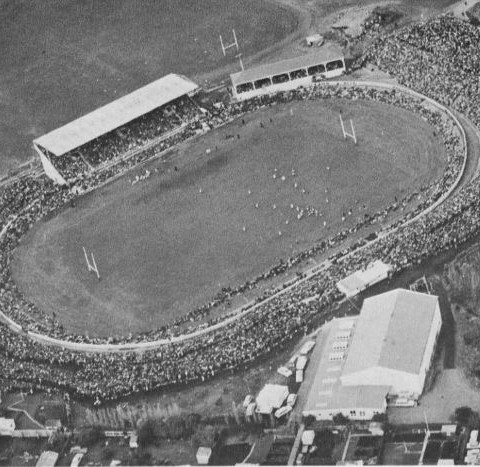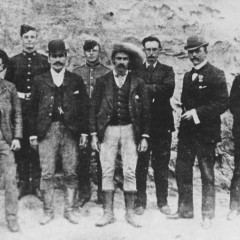15:2
From 1865 to 1972 the Imperial Hotel on the corner of Currie and Devon Streets, now occupied by a block of offices, enjoyed a 'national reputation founded on rare hospitality and good service' .It was built by the New Plymouth firm of Watson and Brown for $3600 for William Henwood, who called it the 'Traveller's Hotel'. Henwood was refused a licence because it was alleged he had 'sold spirituous liquor to the natives', and the licence reverted to C. Autridge, who named the hotel the Imperial. During its 107-year life it had many distinguished travellers from all over the world. One of the most powerful visitors (certainly the briefest) occurred between 9 a.m. and 9.05 a.m. on November 15, 1894. The Taranaki Herald reported: 'This morning a bull ... broke away from a mob in Powderham Street and, rushing along Currie Street, he made into the back yard of the Imperial and somewhat astonished Host Raines by rushing in through the back door, along the passage and out of the door opening on Devon Street , In common with other hotels during the early years the Imperial had a succession of licensees,
including Audus Raines (who made extensive alterations and additions), and, Miss Mary Hearn, of Wellington (1891-1893). In 1929 a private company, Taranaki Properties Ltd, bought the building, and sold it to Charles Acheson in 1961, who had been licensee from 1954. Acheson, a colourful figure regarded with great affection, especially by the rugby fraternity during the Taranaki's tenure of the Ranfurly Shield (1963- 1965) sold the hotel to Taranaki Brewery, and when this company was merged with Dominion Breweries, the licence was transferred to the newly built Ngamotu Tavern in 1972. Before it became a hotel in 1859, the White Hart building had been used for a variety of purposes. It was built in 1844 as a six-roomed private house and R. Rundle, builder and ship-owner, lived in it under lease from F. A. Carrington for 10 years. Its subsequent tenants included various new arrivals waiting to acquire their own homes. These included A. H. Gaine (after whom Gaine Street was named), Henry Shuttleworth and the Rev. W. Woon. This period of its existence earned it the name of the Home of the Destitute. In 1855 the building was used as a military hospital. As the danger of war approached and soldiers from the Marsland Hill barracks were treated in the 'wards', it became known as Bleak House and Itch Hospital, according to W. H. J. Seffern, writing in a series of articles in the New Zealand Graphic in 1897. In 1859 A. Smith, who had conducted a canteen at Ornata, obtained a licence to sell liquor and cater for travellers in Itch House even though the notice above the door proclaimed it the White Hart. Henry Shuttleworth held the licence from late in 1859 until 1873, having failed in at least two attempts to sell its contents at auction. In 1886 Newton King sold the old house at auction for removal and a new, larger White Hart took its place. Further alterations and additions were made when Mrs Rebecca Tabor acquired the hotel from John Veale Dingle. In 1901 she spent $4000 on the building, and one of the additions was the statue of a life-size white hart above the Devon Street-Queen Street corner. Made by a Mr Andrews at the Wanganui Technical School, the body was made of wood and the legs of metal and it was fitted with natural 12-point antlers. During Taranaki's tenure of the Ranfurly Shield in 1964 the hotel was fully booked out with a visiting team's supporters. During that Saturday night the White Hart lost part of its anatomy-but few passers-by noticed that for the last 16 years the hart stood on only three legs.* The White Hart was renowned for its hospitality, as were most of the other hotels in the town. On July 17, 1931, an article in the Yorkshire Evening News carried the following item by English writer Miss Dora West, who had just completed a tour of New Zealand: 'To see New Zealand having been a lifetime dream, it was in eager anticipation that I rolled on my cargo ship into New Plymouth one wet and stormy April afternoon, when the weather seemed entirely home-like and the White Hart Hotel opened hospitable doors to welcome the stranger, its very name seemed to smack comfortably of an English country town. Its dinner, praise God, did not! All over New Zealand, this producing country of plentiful good food, one may be royally fed for three shillings or half a crown (30c or 25c), and that first night ashore after eight weeks at sea,
I fared sumptuously on oyster soup and schnapper fish, lamb and chicken, peas and sweet potatoes, peach pie, passion fruit and cream- such bowls of cream-for this is the rich green country of the Taranaki Province, noted as a dairy land the New Zealander is a great trencher-man, and all dinners being served at six or six-thirty p.m. a generous buffet supper is spread at nine o'clock, when rounds of beef and ox tongues appear, flanked up by piled-up plates of scones and butter, and mighty pots of coffee and tea. How they ever manage to sleep on it I cannot imagine, but everyone looks burstingly well. Tea must indeed be beneficial, for it is drunk from early morn till last thing at night, after every meal as a matter of course, and in between .... ' The White Hart was only one of several New Plymouth hotels which had a reputation for pleasures of the table-which extended to the public bars .. The subject of hours of sale had been a contentious one ever since 1842 when hours were fixed at 6 a.m. to 10 p.m. on weekdays (with extensions to midnight in certain circumstances) and 1 p.m. to 7 p.m. on Sundays. In 1848, William Batten, of New Plymouth, wrote to a friend in England.
'There are two public houses here and landlords pay £30 ($60) a year for a ten o'clock licence, and £40 ($80) for a 12 o'clock one ... beer costs four shillings (40c) a gallon (In 1980 a 745ml bottle of beer cost $1.05.) Six o'clock closing was introduced in 1917 as a war economy measure. After a few years this resulted in what critics described as 'the 6 o'clock swill', especially in the larger cities. No doubt encouraged by the theory that eating between drinks encouraged drinking and perhaps reduced drunkenness, hotel proprietors introduced counter lunches, uncharitably referred to as 'scraps from the kitchen'. In most New Plymouth hotels these were far from scraps. They consisted of large trays of hot savouries, cold meats, a variety of cheeses, rolls, and, on special occasions, crayfish and oysters. Frequently landlords would 'shout' their customers. Both these much- appreciated customs ceased following the introduction of 10 o'clock closing in 1967. Hotel fires hold an unenviable record in New Plymouth. The Harbour View Hotel was a two-storey wooden structure built in 1882, near the port. For several years there were almost annual changes in licence holders. In 1886 the name was changed to the Moturoa Hotel. Fire reduced the building to ashes on August 8, 1897, when two people died-Captain W. Turner, master on the harbour board dredge, and a Canadian oil drilling expert, W. E. Drader. Another guest, C. Hebber- ley, escaped with severe burns after jumping to the road from his second-storey bedroom. The following year a new wooden hotel was built nearer the town on its present site in Breakwater Road, on harbour board land under lease in perpetuity. This, too, was destroyed by fire in 1917. It was replaced by a concrete structure and renamed the Breakwater Hotel, and in 1966 yet another fire reduced it to a shell. The present Paritutu Tavern arose from the ruins. The owner was Len Collett of New Plymouth, and the licence belonged to New Zealand Breweries. The Lion Tavern, on the corner of Egmont and St Aubyn Streets, opposite the railway station, was built on the ashes of two hotels. The first, the Commonwealth, was built in 1901 and incorporated all-electric fittings, a novelty at the time. Less than a year later it was destroyed by a fire presumably caused by a fault in the electric system.
A fireman, George Parker, died from injuries after piercing his foot on a red hot nail. The licensee, Jerry O'Driscoll, rebuilt it in 1903, naming it the Grosvenor. Fire struck again in August, 1957, when a 23-year old housemaid, Miss Joan Morris, died, having fallen from her upstairs room when the floor collapsed in flames. Her body was found the following morning. The Grosvenor changed hands many times during its 56-year history. In 1970 the present Lion Tavern was built on the site by New Zealand Breweries. The Tasman Hotel was also the victim of several fires, at least two of which necessitated almost complete rebuilding. This hotel began life as the Beach Hotel in 1873 with the licensee Francis McCusker. Nearby was Beach Cottage, now Richmond Cottage, built in 1853-54 for C. W. Richmond and his family, which the city council, the New Zealand historic Places Trust and Taranaki Breweries Ltd moved to its present site in 1963. After the railway came to New Plymouth in 1875 the hotel's position near the station resulted in changes of name. First it was the Railway Hotel, then the Terminus, the Tasman Hotel and now the eight-storey Hotel Tasman. For 72 years prior to 1937, the State Hotel on the corner of Devon and Gover Streets was known as Red House Hotel. Built in 1865 by Richard Langman, the first licensee, Josiah Flower Carter, went bankrupt the following year and Langman took over the licence. In common with other hotels, the Red House was the centre of social and sporting activities in addition to its services to drinkers and travellers. The Star Rugby Club had its origin in the Red House, which was used as a dressing room for their' Starlight Club' , later the Red House Club and still later, Star. Practices were held in the hotel grounds. The building was a small wooden one to which additions were made as economic circumstances (and a fire and a storm which blew down the chimneys demanded. The Red House name changed to the State Hotel in 1937. At that time it was conducted by Mr and Mrs Adam Lile. As the Red House and the State it was in the Lile family ownership for 49 years. Pat Lile, a son, was manager until his retirement in 1972. In 1980 building began on a new $700,000 Cobb and Co. restaurant for the New Zealand Breweries. Early records':' show that the Ship Inn, under the proprietorship of W. P. Murch, existed on the site of the present Criterion Hotel in 1852. It was bought by James Paul, brewer, in 1888, who demolished it and built the Criterion, and sold it a year later to W. Cottier, of the Masonic Hotel. Among the many subsequent lease-holders perhaps the best known was Dan O'Brien, a keen sports supporter, and the licensee from 1908 for several years. He donated the Dan O'Brien and Carbine Shields to Taranaki rugby football, the latter in honour of his champion racehorse of that name. He also owned several other champion horses, including Tasman, who won the first New Zealand Cup, and Loyalty. In 1937 the hotel was sold to Dominion Breweries, this company's first purchase in Taranaki.

